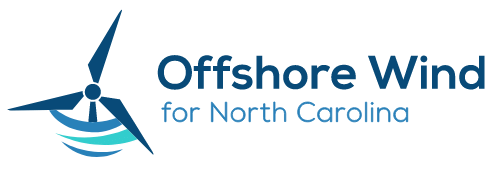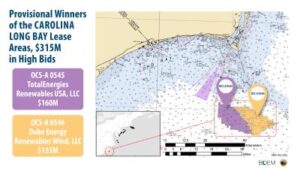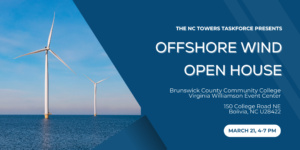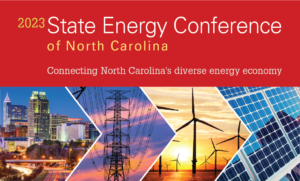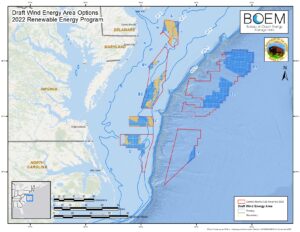
Offshore Wind News
Key Players and Agencies
Federal
Bureau of Ocean Energy Management (BOEM)
BOEM is responsible for offshore renewable energy development in Federal waters. The program began in 2009, when the Department of the Interior (DOI) announced the final regulations for the Outer Continental Shelf (OCS) Renewable Energy Program, which was authorized by the Energy Policy Act of 2005 (EPAct).
Department of Energy (DOE)
The U.S. Department of Energy's Wind Energy Technologies Office (WETO) funds research nationwide to enable the development and deployment of offshore wind technologies that can capture wind resources off the coasts of the United States and convert that wind into electricity.
National Ocean and Atmospheric Administration (NOAA) Fisheries
NOAA Fisheries is responsible for the stewardship of the nation's ocean resources and their habitat. NOAA works with the offshore wind industry on minimizing the impacts to ocean resources, critical habitats, and fishing opportunities throughout the planning, siting, and development stages.
State of North Carolina
North Carolina Department of Environmental Quality (NC DEQ)
The North Carolina Department of Environmental Quality (DEQ) is the lead stewardship agency for the protection of North Carolina's environmental resources. The State of North Carolina works with federal agency partners to responsibly identify offshore wind opportunities for North Carolina’s outer continental shelf.
North Carolina Division of Marine Fisheries (NC DMF)
The North Carolina Division of Marine Fisheries (DMF) is responsible for the stewardship of the state's marine and estuarine resources. The DMF's jurisdiction encompasses all coastal waters and extends to 3 miles offshore.
Mid-Atlantic Fishery Management Council (MAFMC)
The Mid-Atlantic Fishery Management Council is one of eight regional fishery management councils established by the Magnuson-Stevens Fishery Conservation and Management Act in 1976 to manage fisheries within U.S. federal waters.
South Atlantic Fishery Management Council (SAFMC)
The South Atlantic Fishery Management Council, headquartered in Charleston, S.C., is responsible for the conservation and management of fish stocks within the federal 200-mile limit of the Atlantic off the coasts of North Carolina, South Carolina, Georgia and east Florida to Key West.
North Carolina Resources
North Carolina Projects
Carolina Long Bay
The Carolina Long Bay lease area consists of approximately 110,091 acres off the coast of Brunswick County, NC, and is split between energy giants, TotalEnergies and Duke Energy. The area has the potential to unlock over 1.3 GW of offshore wind energy and power more than 500,000 homes.
The Southeastern Wind Coalition (SEWC) commissioned visualizations of the Carolina Long Bay WEA to provide the public an accurate view of what turbines would look like from shore. Digital versions of the visualization are available in the Wilmington East Visualization Presentation and visualization specifications are available in the Wilmington East Visualization Report
Kitty Hawk Wind Energy Area
Kitty Hawk Offshore is a 122,405 acre offshore wind project more than 24 nm offshore from the Outer Banks, and has the potential to support 2.5 GW of offshore wind energy and power approximately 700,000 homes.
Learn more about the Kitty Hawk project from the Kitty Hawk Virtual Self-Guided Open House organized by Kitty Hawk Offshore.
State of North Carolina Resources
North Carolina Taskforce for Offshore Wind Economic Resource Strategies (NC Towers)
NCTowers, the North Carolina Taskforce for Offshore Wind Economic Resource Strategies, provides expert advice to Governor Cooper and state policymakers on ways to advance offshore wind energy projects in North Carolina, with a special focus on economic development and job creation.
North Carolina Offshore Wind Supply Chain Registry Database
The North Carolina Offshore Wind Supply Chain Registry Database was established by the Department of Commerce and is designed to identify which products and services companies can provide to the development, construction, operations and maintenance of offshore wind farms.
North Carolina OSW Supply Chain & Infrastructure Assessments Report
BVG Associates conducted an extensive assessment of the state’s strategic position for the offshore wind industry. The report finds that North Carolina has multiple port and water-front properties well-suited to support the OSW industry currently developing off the U.S. East Coast.
North Carolina Executive Order 80: North Carolina's Commitment to Address Climate Change and Transition to a Clean Energy Economy
Governor Roy Cooper Executive Order No. 80 highlighting North Carolina’s commitment to fight climate change and lead North Carolina’s transition to a clean energy economy. The executive order calls for the State of North Carolina to protect North Carolina’s environment while growing clean energy technologies.
North Carolina Executive Order 218: Advancing North Carolina's Clean Economic and Clean Energy Future with Offshore Wind
Governor Roy Cooper's Executive Order No. 218 highlights North Carolina’s commitment to offshore wind power as the state transitions to a clean energy economy, including offshore wind development goals of 2.8 gigawatts off the North Carolina coast by 2030 and 8.0 GW by 2040.
North Carolina Clean Energy Plan
This North Carolina Clean Energy Plan (CEP) is prepared by the North Carolina Department of Environmental Quality (NCDEQ) to foster and encourage the utilization of clean energy resources and the integration of those resources to facilitate the development of a modern and resilient electric grid as directed in Executive Order 80.
Economic Development
North Carolina Offshore Wind Cost Benefit Analysis
The North Carolina Cost-Benefit Analysis was conducted by the Southeastern Wind Coalition (SEWC) with support from Environmental Entrepreneurs (E2), and found that constructing 2.8-gigawatts of offshore wind off North Carolina’s coast by 2030 will result in a net economic benefit of up to $4.6 billion for the state’s economy.
Offshore Wind: Generating Economic Benefits In North Carolina
The NC Department of Commerce Offshore Wind Energy Project Economic Impact Analysis demonstrates North Carolina's opportunity to capitalize on the local economic impact associated with OSW projects developed off its own coast along with a focused, successful effort to develop a strong OSW supply-chain in the state.
Business Network for Offshore Wind 2022 U.S. Offshore Wind Market Report & Insights
The Business Network for Offshore Wind’s annual U.S. Offshore Wind Market Report & Insights provides analysis of both federal and state government activities. This timely, member industry report ensures companies are informed on the government policies and offshore wind industry developments affecting their business.
ACP Economic Impact Study of New Offshore Wind Lease Auctions by BOEM
American Clean Power (ACP) commissioned a study from research group Wood Mackenzie, which finds that the United States has an opportunity to accelerate offshore wind energy growth and benefit from 28 new gigawatts of clean energy and $1.7 billion in U.S. Treasury revenue by 2022.
ACP Federal Revenue and Economic Impacts from BOEM Offshore Wind Leasing
This American Clean Power (ACP) study forecasts the revenue that BOEM could expect to accrue both from the sale of seven offshore wind lease areas and the long-term rents and operating fees paid by projects developed in those areas. Economic impacts from these future projects are also calculated.
NREL Supply Chain Road Map for Offshore Wind Energy
The National Renewable Energy Laboratory (NREL) is leading the 30 GW by 2030: A Supply Chain Road Map for Offshore Wind in the United States project to create a road map that identifies challenges and solutions to developing a nationally focused offshore wind energy supply chain that has the potential to manufacture all major components domestically by 2030.
Environmental Impacts
Environmental Impacts and Siting of Wind Projects
The Wind Energy Technologies Office (WETO) works to understand and mitigate barriers to wind power deployment by conducting research and development activities aimed at addressing siting and environmental issues. When properly sited, wind projects provide a net environmental benefit to the communities in which they operate and to the nation overall.
Offshore Wind Energy Resources and the Environment
Establishing environmental parameters is an important piece of the Wind Energy Technology Office's research agenda. This includes characterizing offshore wind resources, understanding the environmental impacts of offshore wind construction on wildlife and the marine environment, and mitigating the impact of offshore wind turbines on radar and other communication and navigation equipment.
Wind Turbines in Extreme Weather: Solutions for Hurricane Resiliency
Although hurricanes and the damage they can cause remain difficult to predict, with current R&D, the Energy Department is taking steps to alleviate potential risks to offshore wind systems that will eventually be deployed in the southeastern and mid-Atlantic regions.
